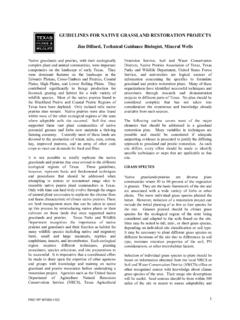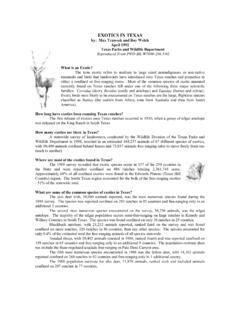Transcription of American Elk - USDA
1 American Elk (Cervus elaphus) November 1999 Fish and wildlife Habitat Management Leaflet Number 11 General Information Before European settlement, an estimated ten million elk roamed the North American continent. The American elk (Cervus elaphus), or wapiti, a Native American word meaning white rump, once had the largest range of any deer species in North America. For centuries, the elk has been a picturesque icon of the American west and has pro-vided recreational opportunities for hunters, photographers, artists, and other wildlife enthusiasts. Unregulated hunting, grazing compe-tition from domestic livestock, and habitat destruction from unre-strained timber harvesting, urbanization, and westward expansion throughout the nineteenth century reduced American elk populations to less than 100,000 individuals continent-wide by the early 1900s.
2 Fortunately, the elk s ability to use a variety of habitats, its opportun-Bull elk istic feeding habits, and positive response to management efforts has enabled the species to survive natural and human-induced pressures over time. These factors, coupled with concentrated wildlife management efforts, have returned the American elk to stable, and in some areas increasing, populations in the United States and Canada. This pamphlet is designed to serve as an introduction to elk habitat requirements and to assist private landowners and managers in developing elk management plans. Success of any individual species management plan depends on targeting the specific needs of the desired species, analyzing the desig-nated habitat area as a whole to ensure that all required habitat elements are present, and determining what management techniques will best improve the land as elk habitat.
3 Range Four subspecies of American elk live in North America today. The tule elk (C. elaphus nannodes), the smallest of the subspecies, once freely roamed the valleys of central and northern California. Today, many of the approximately 3,000 tule elk that remain are managed by state and federal agencies on California public lands. The Manitoba elk (C. elaphus manitobensis) once occurred primarily from Colorado north into Canada along the eastern edge of the Rocky Mountains; however, it did range east into Minnesota and south into northern Texas. Today, the majority of the Manitoba elk population (approximately 20,000 individuals) are found in the provincial and national parks of Manitoba and eastern Saskatchewan, Canada.
4 The Roosevelt elk (C. elaphus roosevelti) and the Rocky Mountain elk (C. elaphus nelsoni) are the largest and second largest living elk subspecies in North America, respec-tively. The Roosevelt elk population, approximately 91,000 strong, ranges along the Pacific coast from northern California to Washington and Canada. The Rocky Mountain elk is the most plentiful of the four elk species (800,000 to 900,000 individuals) and occurs primarily in the mountain ranges east of the Cascade Mountains. However, because of its adaptive nature and variable diet, sustainable populations of Rocky Mountain elk have been successfully introduced or repatriated into historical habitats in many western and eastern states.
5 Rocky Mountain elk now occur in parts of Alaska, Ari-zona, Arkansas, California, Colorado, Idaho, Kentucky, Michigan, Minnesota, Montana, Nevada, New Mexico, North Dakota, Oklahoma, Oregon, Pennsylvania, South Dakota, Texas, Utah, Washington, American elk (Cervus elaphus) and Wyoming. Because of limited population size and/or range of tule and Manitoba elk, this leaflet concentrates on the habitat needs and management of Roosevelt and Rocky Mountain elk. Habitat Requirements General Elk habitat consists of a mosaic of woodland cover and large open areas. Woodland habitat provides escape cover from human disturbance and predators, and wooded corridors provide travel lanes among seasonal habitats.
6 Open areas provide necessary herbaceous forage. Tule elk find suitable foraging and protective cover in various isolated, open coastal regions of California. Because preferred habitat and weather conditions remain constant in these regions, tule elk do not seasonally migrate. Roosevelt and Rocky Mountain elk migrate from one area to another according to season and weather conditions. These two subspecies occupy mountain forests and meadows, valleys, foothills, bottomland wood-lands, and open plains throughout the year. Adequate winter habitat in the form of lowland woodland cover is crucial for elk survival. Loss of winter range to development, logging, grazing, agriculture, and other intensive land uses continues to potentially threaten elk populations in certain areas.
7 Loss of native winter range can also create management challenges by wintering elk in developed areas and agricultural settings. Preserving and properly managing woodlands and open areas can assist landown-ers in supporting elk populations, as well as populations of other species that rely on similar habitat. Food Elk native diets consist of a wide seasonal variety of green and dried grasses , forbs, and woody plants. grasses such as native bluegrasses, rough fescue, Idaho fescue, prairie junegrass, needlegrasses and bluebunch, and slender and thickspike wheatgrasses are the primary foods in the spring and summer along with sedges and early forbs.
8 As summer progresses, more forbs and woody browse, such as shrub twigs and branches are consumed. Dry grasses and browse are consumed heavily in autumn. Elk prefer grass, but regularly feed on serviceberry, willow, buds of red osier dogwood, antelope bit-terbrush, snowberry, mountain mahogany, winterfat, aspen shoots, western juniper, sagebrush, and other shrub and browse species during winter months. Elk are opportunistic feeders, and will eat any of the plant species listed below when available. However, elk seek to consume a mixture of grasses , forbs and shrubs in winter to ensure proper intake of nitrogen. Important elk food items.
9 The following food items comprise a skeleton list of common foods consumed by elk. This list is not exclusive; other foods are consumed when available. Items listed in bold print are of particular value for their usefulness as winter foods. grasses , sedges and forbs: native bluegrasses wheatgrasses fescues prairie junegrass beargrass needlegrasses American bistort buckwheat elk sedge dandelion daisies lupine elk thistle fireweed cow parsnip scarlet falsemeadow penstemmon golden currant chokecherry clovers vetch Woody vegetation and shrubs: huckleberry serviceberry willow antelope bitterbrush snowberry mountain mahogany winterfat aspen western juniper sagebrush red osier dogwood Where appropriate, native grasses , shrubs, sedges and forbs listed above may be planted or encouraged to enhance vegetation that already exists in and around open field areas and woodland cover.
10 Adding native species will typically enhance food availability for elk. 2 American elk (Cervus elaphus) Summer range Elk in the northwest and other regions of the country that experience high snowfall and severe winter conditions typically migrate to higher elevations in summer once adverse winter conditions subside. Protection from human disturbance is a major factor luring elk to summer ranges. A general lack of disturbance provided in the high country woodlands and pastures of national forests, wilderness areas, and national parks makes these lands common elk summer ranges. New grasses and forbs and wood-land cover provide the necessary summer food and cover requirements for elk.












